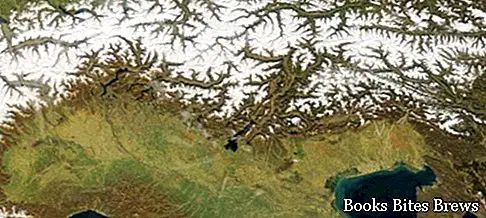Extended for over 1200 km from east to west, the Alpine chain forms an arch that occupies an area of 225,000 square kilometers, affecting European states such as Austria, France, Italy, Slovenia, Switzerland and Hungary.
Natural climatic barrier
The average width of the chain varies between 120 and 150 km, reaching a maximum of 200 km at Lake Como.
The western part of the Alps attenuates the penetration of humid air masses from the Atlantic.
The Alps represent a climatic barrier, inserted between the north and south of Europe, which marks the climatic border between the southern Mediterranean and northern continental areas.
Geophysical characteristics
Located among the major outbreaks of Western Europe, the Alps are among the most original mountains in the world, with large valleys that allow easy access.
The crossing of their passes and passages since ancient times, together with the function of refuge that they have assumed in the past towards numerous populations, have allowed to know their varied regional characteristics very quickly.
The areas with the highest altitude, with peaks over 4000 meters, are found grouped in the central western sector of the chain.
These include the Mont Blanc massif, the Pennine Alps and the Bernese Oberland.
From one side to the other, to the south and east, the altitudes gradually decrease, making the mountainous mass appear as a double asymmetrical slope roof.
In the Alps there is an internal superelevation axis, corresponding to the oldest rocks, which are for this reason deeper and more resistant.
These are crystalline and metamorphic rocks, including granite, shale, crystalline and gneiss.
Recommended readings- Artimino (Tuscany): what to see
- Giulianova (Abruzzo): what to see
- Alessandria (Piedmont): what to see in 1 day
- Corigliano Calabro (Calabria): what to see in the medieval village
- San Galgano (Tuscany): what to see
To the north-west and south-east of the orographic axis, sedimentary masses develop, mostly limestone, which were bent and deformed during the mountain's lifting phase.
Extension of the Alps
The Alpine chain begins in the west and south with the Argentera massif, the first in a series of crystalline massifs, which continues north to the Mont Blanc massif, the highest peak in the chain by altitude with its 4810 meters.
From that point, the orientation becomes west-east, with the Aare massif, the Pennine and Lepontine Alps, the Bernina massif, the Rhaetian Alps and the Sivretta, this in Swiss territory.
In Austria the chain continues with the Otztal, Zillertal, Hohe Tauern and Lower Tauern massifs, while in Italy with the Adamello massif.
Those mentioned represent the highest massifs, those that carry the main glacial complexes, the water reservoirs from which many streams and rivers that feed large waterways such as the Rhine, Rhone, Po and Danube derive.
On both sides of the crystalline central axis lie the limestone massifs of the French Prealps, the Swiss and Austrian Alps, the Bergamo Prealps and the Venetian Prealps, the Dolomites, the Carnic Alps and the Julian Alps in Italy.
The calcareous comprade that are located at an average altitude of not more than 2000 meters and are located on the outskirts of the mountainous axis, are characterized by abundant rainfall, a factor that has favored the presence of dense forests.
The Alpine valleys
One of the greatest originality of the Alps are wide valleys with a flat profile, such as those of Isere, Dora Baltea, Rhone, Rhine, Inn, Ticino, Adige and Drava.
The Alps have always been a point of reference for climbers from all over the world, who have been conquered by the splendor of those magnificent peaks.




